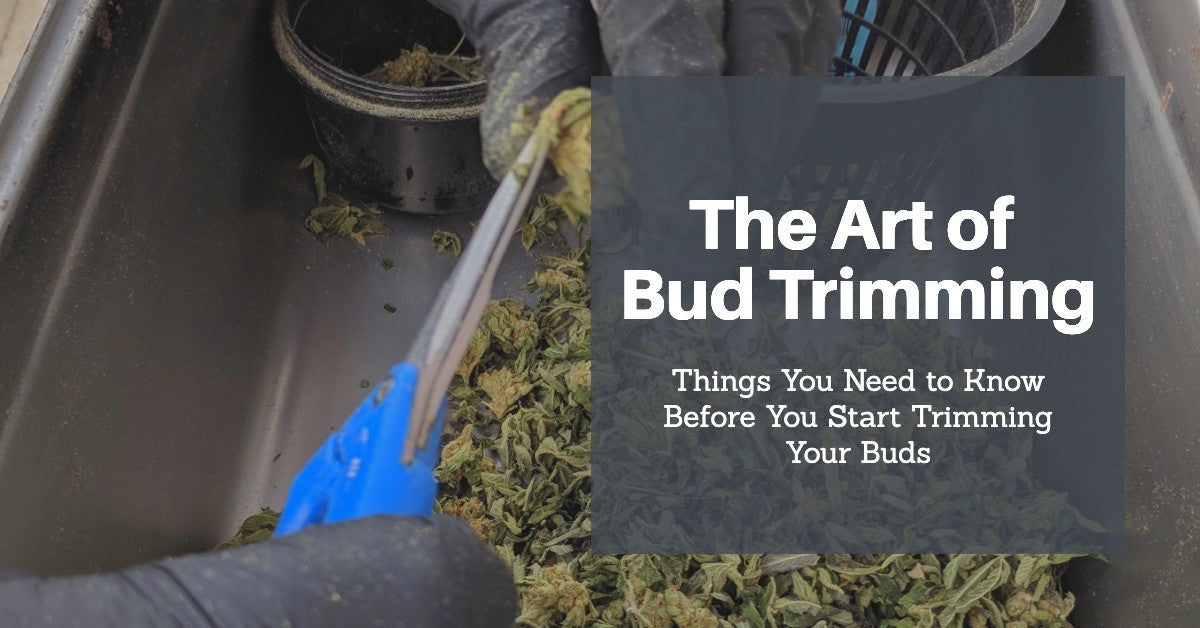
There is more to trimming buds than for aesthetic purposes. Aside from making your favorite strains look neater when they hit the dispensaries, removing the protruding leaves also help create an optimized flavor.
The leaves, called sugar leaves, on your buds have lesser trichome concentration. By removing the sugar leaves, you get to expose the nugs, which have more trichomes. Also, sugar leaves usually have harsher smoke as they are thicker and tougher to in wicking away moisture. When you cure trimmed buds, the moisture content is consistent and provides a more flavorful experience. Since Croptober is just around the corner, let’s take a look at the things you need to know about trimming buds.
When Should You Trim Cannabis Buds?
Ideally, you should start trimming days before you begin the harvest process. At this stage, growers usually start removing fan leaves when senescence, or when larger fan leaves start wilting, begins. If time and resources permit, consider removing them before harvesting, so you reduce the effort when you trim after harvest.
Should You Trim Wet or Dry?
There are advantages and disadvantages to trimming wet and dry. Each has their benefits, which affect efficiency and quantity.
Wet trimming is ideal if you want to protect your buds from molds, especially in highly humid climates. Buds also dry faster when you remove the sugar leaves on it. On the logistical side, bud trimming before drying gives you more space on your drying racks.
But, trimming wet buds can be tedious as buds can get very sticky. The buds may also dry too fast, which reduces the flavor profile. They lose density, which affects the quantity later on.
Meanwhile,
dry trimming is perfect for areas with low humidity. Dry trimming also makes your buds look better and gives it a nugget-like shape. It also allows a slower drying rate and maintains more flavor than wet trimmed buds.
Dry trimming has disadvantages as well. For one, keeping the sugar leaves on before drying keeps pockets of moisture that can become molds. You also lose the initial color quickly, and dried sugar leaves also shrink and become harder to cut for a neat look.
Hand-Trim or Automatic Trimmer?
It’s tempting to jump on the
automatic trimmer train, given the array of options for all sizes of operations and versatility. Some manufacturers even include specific tools to help you cut dry buds, which can be more challenging than wet buds. But, automatic trimmers cost money, and trimmers are not equal, as results still vary from one trimmer to another.
There is also something about trimming buds by hand: you get better precision, plus there’s a more boutique feeling to these buds. But hand trimming also costs money, when you decide to hire more people to help you in the job. It is also time-consuming, especially when you don’t have enough people to help you. Trimming by hand also means more handling of the bud, especially when it is still wet and locked with moisture.
Trimming with CO2: A Cutting-Edge Method
This technique hinges on exposing buds to CO2 using equipment, like those akin to the Resinator or Tom's, effectively freezing and hardening them for a more streamlined trimming and optimal trichome preservation.
When cannabis buds are exposed to CO2, trichomes become brittle, effectively stiffening the plant material. This simplifies the trimming process as the hardened, frozen sugar leaves become more manageable and easy to remove. This method also prevents trichomes, the plant's most potent component, from being lost in the trimming process as it significantly reduces the bud's stickiness, a common concern when trimming wet buds.
The CO2 method has benefits for both small scale and large scale operations. It combines the advantages of wet and dry trimming, as it allows for a more even moisture content and consistent flavor profile, while avoiding risks associated with molds. It also overcomes logistical issues of wet trimming, providing more space on drying racks without compromising the quality of the buds. CO2 trimming is available from certain
Other Things To Remember
When trimming cannabis, make sure you have a clean space, whether you do it by hand or machine. You would not want to get your buds contaminated by foreign objects or substances around you. After trimming those buds, do not throw away the leaves and other waste. You can still process these into other goods such as cannabutter, bubble hash, among other things.
Conclusion
Indeed, there are many ways to skin a cat, or in this case, trim a bud. Given all advantages and disadvantages, it is up to you to choose which one fits your needs best. Choose your trimming preferences based on what is practical for you. Given the pros and cons of every trimming aspect, your choice should complement your whole setup. At the end of the day, whatever preference you lean on, it must contribute to your targets for the upcoming batch of your harvest.




